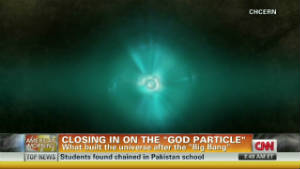How particle smasher and telescopes relate
STORY HIGHLIGHTS
- "Everybody is ... an amateur astronomer," scientist says
- But particle science is harder for the average person to grasp
- Understanding particles can lead to technologies everyone can use
(CNN) -- A $10 billion machine that smashes particles together is shutting down this weekend, taking a staycation in its 17-mile tunnel near the French-Swiss border while receiving maintenance and upgrades. The Large Hadron Collider, one of the world's largest science experiments, will resume operations in 2014 or 2015 at unprecedented energies.
Do you care?
Judging from the many comments that we get at CNN.com about what people perceive as a "waste" of money for scientific exploration, you might not. That may be because what happens at the LHC seems far removed from everyday life, and even farther from the study of stars.
"Everybody is, in some sense, an amateur astronomer. We all look up at the stars and wonder how the universe works," says Joel Primack, professor of physics and astrophysics at the University of California, Santa Cruz. "People are not amateur particle physicists."
Our window into outer space is visible and dazzling. We can see spaceships and telescopes launch into the sky, and we can see the images they send back.
Inner space, the fundamental building-blocks of everything on a ridiculously small scale, isn't visible. A lot of our understanding is based on theory and probability. Even the greatest achievement at the LHC isn't certain; we can only say that a particle was found resembling a theorized entity called the Higgs boson.
But exploring the very small and the very big and distant are both important for understanding the world in which we live, scientists say, and are necessary for completing the same puzzle.
"The basic story is really that understanding particles and interactions helps us understand the evolution and structure of the whole universe, and hopefully will give us technologies that will allow us to explore it more efficiently and solve energy problems and so forth," said Joe Incandela, spokesperson for the LHC's Compact Muon Solenoid experiment, a large particle detector.
What the universe is made of
Over the last few decades, scientists have come to the conclusion that the universe's composition is only about 5% atoms -- in other words, the stuff that we see and know around us. That means the rest is stuff we can't see. About 71% is something called "dark energy," and another 24% is "dark matter."





Research is ongoing to figure out precisely what these "dark" components are, because they do not interact with ordinary matter and have never been directly detected.
But the large-scale structure of the universe depends on dark matter. "Without the dark matter, all the stars would fly away," said Adam Riess, physicist at Johns Hopkins University and the Space Telescope Science Institute.
Dark energy is thought to be responsible for the accelerating expansion of the universe, and Riess'sNobel-prize winning work supports this theory.
In principle, these phenomena are everywhere -- but how can we find them?
What particle physicists are really looking for
All that space in between star clusters is not empty at all. Particle physicists are hoping to get a better understanding of space time, the fabric of the universe.
There are particles hiding behind this fabric that we don't normally see, but with enough energy you can draw them into existence, Incandela said. Scientists expect several as-yet-unseen particles to be there because they help fill gaps in the Standard Model of particle physics. The LHC uses high-energy particle collisions to try to find them.
Incandela likens this to being in a boat with fish underneath, which are nibbling at the surface. It takes a lot of energy to pull one out. The Higgs boson, being so hard to pin down, would be like a whale, Incandela said.
One pitfall of this analogy is that you can easily identify real fish, but it's a lot harder to classify particles that slip in and out of existence in less than a second.
The particle that has made headlines recently is the Higgs boson, aka "God particle" -- a term a lot of scientists hate. Nobel Prize-winning physicist Leon Lederman wrote a book with "God Particle" in the title, but reportedly said he'd actually wanted to call it the "Goddamn Particle."
This particle is a component of something called the Higgs field. Brian Greene, theoretical physicist at Columbia University and "NOVA" host, describes it this way:
"You can think of it as a kind of molasses-like bath that's invisible, but yet we're all immersed within it," he said. "And as particles like electrons try to move through the molasses-like bath, they experience a resistance. And that resistance is what we, in our big everyday world, think of as the mass of the electron."
Without this "substance," made up of Higgs particles, the electron would have no mass, and we would not be here at all. It's not a perfect metaphor, though; we don't feel particularly sticky.
The collision energy at the LHC went up to 8 TeV (trillion electron volts) in 2012, a record for the amount of energy in particle collisions. After downtime of about two years, it will come back online with 13 TeV.
"It really feels like we're on the verge of a breakthrough."
Joel Primack, physicist at UCSC
Joel Primack, physicist at UCSC
With higher energies, it may be possible to detect the signature of dark matter, learn more precise properties of the particle that looks like the Higgs, find evidence of extra dimensions and perhaps find out whether gravity itself has a particle.
"If you want to understand the big, you have to understand the small," Primack said.
Dark matter and energy
Primack proposed an idea for dark matter in 1982 that is still a leading contender: The notion that supersymmetry is responsible for dark matter.
That means that for every particle we know, even the Higgs, there is a partner particle with similar interactions but that is more massive. All these partner particles are unstable except for the lightest one, which can't decay into anything else. Dark matter would be this lightest particle, called a weakly interacting massive particle, or WIMP.
There are several underground experiments worldwide that are aiming to detect these dark matter "WIMPs," such as the LUX Dark Matter experiment in the Black Hills of South Dakota, where liquid xenon is stored a mile underground.
Similar experiments include the Xenon 100 experiment at the Gran Sasso Mountain in central Italy. Scientists will go even deeper at thePandaX experiment at the China Jin-Ping Underground Laboratory, located under 1.5 miles of rock.
The principle behind these experiments is that particles hitting the xenon cause the nucleus of the atom to give off a little bit of light. By examining the resulting charge and light produced in this collision, scientists can determine whether dark matter was involved. At least, in theory -- so far, no dark matter has been detected that way.
These experiments are happening at the same time that the LHC is colliding particles, and may find evidence of dark matter that way.
"It really feels like we're on the verge of a breakthrough," Primack said.
Meanwhile, in space, scientists are looking for the signatures of dark matter and dark energy. Riess and colleagues used the Hubble Space Telescope to measure supernovae that are very far away, showing that dark energy must be responsible for how the universe appears to expand faster and faster. This won them the Nobel Prize in 2011.
The James Webb Telescope, costing about $8 billion, will succeed Hubble. The planned telescope will have a 21-foot diameter mirror, six times as big as Hubble's. Among other things, this telescope is also looking for evidence of dark matter and dark energy.
"There's a huge synergy there, in astronomers trying to find the influence of dark matter by mapping stars and galaxies and large structures in the universe, and particle physicists trying to discover the source of that influence of dark matter through subatomic particles here on Earth," said Jason Kalirai, deputy project scientist for the telescope at the Space Telescope Science Institute.
What technology may come
The question remains: What is this all good for?
There's the pure satisfaction of having greater knowledge of the universe in which we live.
"It's just one of the things that distinguishes humanity, that we can actually answer questions that are deep and fundamental, make predictions and do science, and that it actually works," said Lisa Randall, professor of physics at Harvard and author of "Knocking on Heaven's Door."
Consider also that all the technology you know can be traced to pure research, initially perceived as esoteric. Electric lights -- and, indeed all of electricity -- came from fundamental research in the 19th century.
Computers and transistors arose from the understanding of quantum mechanics in the 1920s and 1930s, Incandela said.
Certainly, Einstein didn't know that his relativity theories would become pertinent to your smartphone's GPS. The atomic clocks on satellites must be corrected because, in accordance to Einstein's predictions, moving objects in space are on a different "time" relative to an observer on Earth.
"Technology usually lags pure science by a large amount of time, and I would say, probably now there's a good chance we're further ahead of technology than ever before," Incandela said.
Even the World Wide Web arose out of a proposal from Sir Timothy Berners-Lee, who was a physicist at CERN in the 1980s. Essentially, the reason we have the Internet that we all know and love is that Berners-Lee wanted to enable better communication among physicists there.
It's likely, Primack said, that useful things will also come from the searches for dark matter and dark energy, and for other particles that the LHC is hunting. No one knows what the uses will be yet -- but then again, no one predicted that the World Wide Web would arise at a particle physics lab, either. CERN is, in fact, the same laboratory that houses the LHC.
Nothing is certain, of course, it is at least possible that doing this pure science could help bring into reality the sorts of technologies that right now seem like science fiction.
"If we're really going to explore the universe, in terms of actually moving through the universe and having the ability to do space exploration that's what you see in the movies, so to speak, the 'Star Trek' type things, in principle, we're going to need to understand and have the ability to harness the potential of nature at a level that we don't have now," Incandela said.
 Science on the big scale and the small scale is important for understanding the structure of the universe. The Hubble Space Telescope is looking for indications of dark matter in star clusters, while particle experiments are also hunting down this mysterious substance.
Science on the big scale and the small scale is important for understanding the structure of the universe. The Hubble Space Telescope is looking for indications of dark matter in star clusters, while particle experiments are also hunting down this mysterious substance.
No comments:
Post a Comment